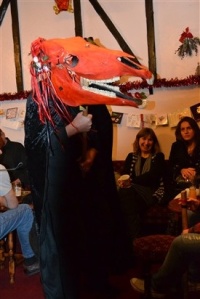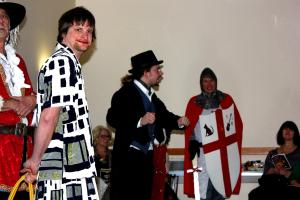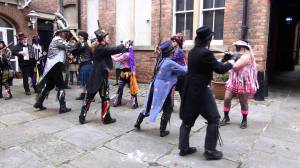New Moon ♉️

We’re long into the merry month of May! The days are longer, the trees are greener and the flowers of both tree and plant are open, giving us a multitude of colour.
Now is the time of rich green leaves on the trees and a whole multitude of coloured flowers: bluebells (see above), forget-me-nots, borage, magnolia, dandelions, dead nettle, tulips, apple trees, plum trees, cherry blossom, hawthorn and more!
Everything growing now was important to our ancestors as it provided fruit and grain for the harvest. Everything growing and blooming now would be vital in produce for both Human and animal. The Anglo-Saxons were said to have described the grass being so plentiful during the month of May, you could milk the cows up to three times a day!
Unlike the Irish Bealtaine, which now begins on the 1st May and the modern English May Bank Holiday (normally the first Monday of May), the beginning of May wasn’t really seen as a special time of itself. For the Anglo-Saxons, the beginning of summer started on the 9th May; although this is going on the Julian Calendar rather than the modern Gregorian Calendar.
May was seen during Anglo-Saxon times as the month when everything starts growing, whether it’s plant, tree, harvest crop or cattle. And bizarrely enough, there were rituals practiced by Christians that read like they may possibly be linked to something older….
Rogationtide takes place five or seven weeks around Easter. If you recall from last month’s post, Easter itself is mutable depending on when it can take place. Ergo, Rogationtide can be celebrated as early as 25th April and up to 12th May, perhaps even later. Rogationtide was enacted by prayers of penance, fasting and an annual presenting of holy relics of the saints into the countryside; bringing the power of God from the church and into the open to give blessings of fecundity to the coming crops and growing cattle. As well as praying for the souls of Man, this was ritual and prayers for blessings on the land.
It is believed this practice was a Christianised version of a pagan Roman ceremony called the Amburbium. Which might explain its rather different approach.
The crowds that gathered for this procession into the fields were so popular that they carried on into the late Middle Ages where this blessing extended from fields to the boundaries of local parishes. This was met with local pride and became seen as local folk re-establishing their own parish borders. This, in time became known as ‘Beating the Bounds’ and was marked with sticks being beat on the boundaries themselves, or crosses being placed at these positions. By the late Middle Ages this was celebrated by the people with lots of cheering, noise making, bell ringing, feasting and communal walks in the countryside.
I, myself, was introduced to the “Beating of the Bounds” in a local camp here in Nottingham. The campers met with most of the children (adults were invited too!), who were encouraged to bring pots and pans and we travelled to each of the four corners of the field that became course campsite; where we whooped, hollered, made an absolute din to mark this space as ours and drive away any harmful spirits!
According to the Anglo-Saxons, there was even a ritual called the Aecerbot or ‘Field Remedy’ to be performed when your field was no longer delivering produce. If this happened it meant your fields were sick or were bewitched and so this plough based ritual was enacted:
Before dawn, four pieces of turf were cut from the four corners of the field. A concoction of oil, honey, yeast, holy water milk from every cow you have and portion of every tree and plant you have was dripped on to these pieces of turf. Prayers were offered as was the Pater Noster (the Lord’s Prayer), a priest would then sing four masses over them before sunset. These pieces of turf were then put back- but each had a wooden cross made of Rowan (for repelling witchcraft) underneath them. Whoever performs the ritual bows to the east nine times, saying a prayer to the east. More prayers and a curious act which involves taking seeds from beggars, but with you giving back twice as many seeds as you took from them. These seeds are then set on your plough then you say:
“Erce, erce, erce, mother of earth, may the All-wielder, the eternal Lord, grant you fields growing and putting forth shoots, increasing and becoming strong, tall shafts, bright crops, and the broad barley-crops and the white wheat-crops and all the crops of the earth. May the eternal Lord and his holy ones who are in heaven grant to him that this field may be protected against every enemy, and guarded against every evil from poisons sown across the land. Now I ask the Ruler who created this world that there may be no talking woman or cunning man who is able to change the words thus spoken.”
You then cut the earth with this plough and seeds, say: “Be well, earth, mother of mankind! Be growing in the embrace of God, filled with food for the use of all.”
You then bake a loaf of bread and lay this in the first furrow that was ploughed and finish with more prayers.
So, with the blessing of the Christian God, the Earth Mother was invoked! And “Erce, erce, erce….” Frustratingly enough this is the ONLY mention of Erce, and if I had to guess, I would say this could be a name of the Earth Mother, perhaps even an Anglo-Saxon derivative of the Earth Goddes Nerthus. But without substantial research and evidence, this is purely my personal conjecture.
The Aecerbot was not limited to any particular time of the year, it could be performed at anytime as long as it was started before sunrise.
The importance of gaining a good harvest in order to provide food for both the community and fodder for livestock was paramount. It seems that the Anglo-Saxons wanted to ensure the health of their crops and cattle- as any good culture must in order to survive! And if this depended on praying to the Christian God as well as borrowing processional ceremonies from pagan peoples of the past, or even calling upon the Earth Mother to bless the fields…. Then to borrow a cliche: the ends justified the means.
Whatever this month means to you and however you celebrate it (if at all), here’s wishing your fields are healthy, your livestock are abundant and your harvest will be a plentiful one! May your boundaries be safe and have a Merry May-time!
Locksley. /|\


